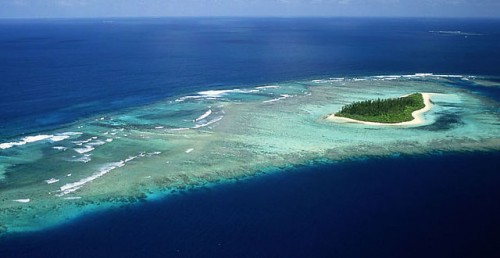More than a thousand low-lying tropical islands risk becoming "uninhabitable" by the middle of the century - or possibly sooner - because of rising sea levels, upending the populations of some island nations and endangering key US military assets, according to startling new research published Wednesday.
The threats to the islands are twofold. In the long term, the rising seas threaten to inundate the islands entirely.
More immediately, as seas rise, the islands will more frequently deal with large waves that crash farther onto the shore, contaminating their drinkable water supplies with ocean saltwater, according to the research.
The islands' face climate-change-driven threats to their water supplies "in the very near future," according to the study published in the journal Science Advances.
The study focused on a part of the Marshall Islands in the equatorial Pacific Ocean. Hilda Heine, president of the Marshall Islands, said in an interview that Wednesday's journal article "brings home the seriousness" of the predicament facing her island nation.
"It's a scary scenario for us," she said.
The research also has ramifications for the US military, whose massive Ronald Reagan Ballistic Missile Defense Test Site sits, in part, on the atoll island of Roi-Namur - a part of the Marshall Islands and the focus of the research.
The US military supported the research in part to learn about the vulnerability of its tropical island installations. The Pentagon base at Roi-Namur and surrounding islands supports some 1,250 American civilians, contractors, and military personnel.
"This study provided a better understanding of how atoll islands may be affected by a changing climate," Defense Department spokeswoman Heather Babb said in a statement.
"While no decisions have been made about Department of Defense activities on the islands based on the study, DOD continues to focus on ensuring its installations and infrastructure are resilient to a wide range of threats.
"The department's understanding of rising sea levels will enable the military services and agencies in affected areas to make informed decisions on how to continue to execute their missions."
The low-lying island, which rises barely 6 feet above the current sea level, is part of the vast Kwajalein coral atoll, a structure that formed as coral reefs grew around a sinking volcanic island long ago.
That's the origin of more than a thousand other low-lying, ring-shaped atoll islands or atoll island chains across the Pacific and Indian oceans. Most are not populated, but some, like the Marshall Islands or the Maldives, are the home of tens or even hundreds of thousands.
While seas are rising by 3.2 millimeters per year at the moment and expected to rise even faster in years ahead, Roi-Namur has a good chance of avoiding total inundation this century.
But the new research - conducted by researchers from the US Geological Survey (USGS), the National Oceanic and Atmospheric Administration, and several other institutions in the US, Monaco, and the Netherlands - suggests that saltwater contamination of the island's aquifers would probably occur at just 40 centimeters (about 15 inches) of sea level rise.
Five to six centimeters globally have already occurred since the year 2000, and sea level rise is even faster at Kwajalein atoll.
The danger comes because of the increasing ability of large waves to spill across the island and sink into its groundwater.
"Historically, there would be an overwash event due to a cyclone or typhoon every 20 or 30 years," said Curt Storlazzi, a US Geological Survey researcher who led the study.
"Every 20 or 30 years, or more, communities can recover in that time. The concern is that with sea level rise, those flooding events are going to happen more frequently."
Wave overwash events already occur - a 20 foot high wave swept across Roi-Namur in 2014 - but the computer model used by the study finds that they become ever more likely as seas rise, and once they occur two years in a row, the groundwater could become undrinkable.
The "tipping point" in the study varies depending upon the rate of climate change - and above all the stability of Antarctica. In the worst case, the paper says it could come "before 2030."
However, a prominent sea level rise expert not involved in the study, Bob Kopp of Rutgers University, questioned that especially dire finding in an interview with the Post.
"They're asking the right questions, they're doing the right sorts of analysis, but I'm a little skeptical of some of their early century dates for some things," said Kopp.
For less dire scenarios, the critical moment is pushed farther off to the decade between 2030 and 2040 for a high warming scenario without Antarctic collapse, or 2055 to 2065 for a middle range warming scenario.
Kopp said that middle scenario is certainly consistent with what we know, and provided an analysis suggesting that while there is indeed a major threat here, it won't arrive as soon as 2030 but could by the 2050s.
"Even if you take their most conservative scenario, the numbers are really disturbing. And there's nothing wrong with their conservative scenario," he said.
The study underscores why many small island nations clamored to ensure that the 2015 Paris climate agreement included language requiring the world to strive to limit global warming to just 1.5 degrees Celsius (2.7 degrees Fahrenheit) above preindustrial levels, an extremely stringent target.
"It's important for people to realize that this is real, it's happening to people. We are not the ones creating this, but we are the ones who have to live with it."
"So climate change will increase the rate of sea level rise, but also it will decrease the possibility for these corals to keep up."
The current study even suggests that if reefs falter - as they are doing around the world - then the major wave risk to coral atoll islands could come still earlier.
Droxler said the current study reminded him of the Maldives, where he has worked, and which faces a situation similar to that of the Marshall Islands.
"The maximum elevation is 2.4 meters, and there are more than 140,000 people living in 2 square miles," he said of the capital island of Male.
"It is kind of the ultimate example of the destiny of these tropical islands which are so low in elevation," said Droxler.
And each passing year, as seas continue to rise and the nations or the world wrestle with how to cut carbon dioxide emissions, thousands of islands grow closer to a reckoning.
"The longer we talk about this," said Conger, "the more the distant future becomes the near future."





